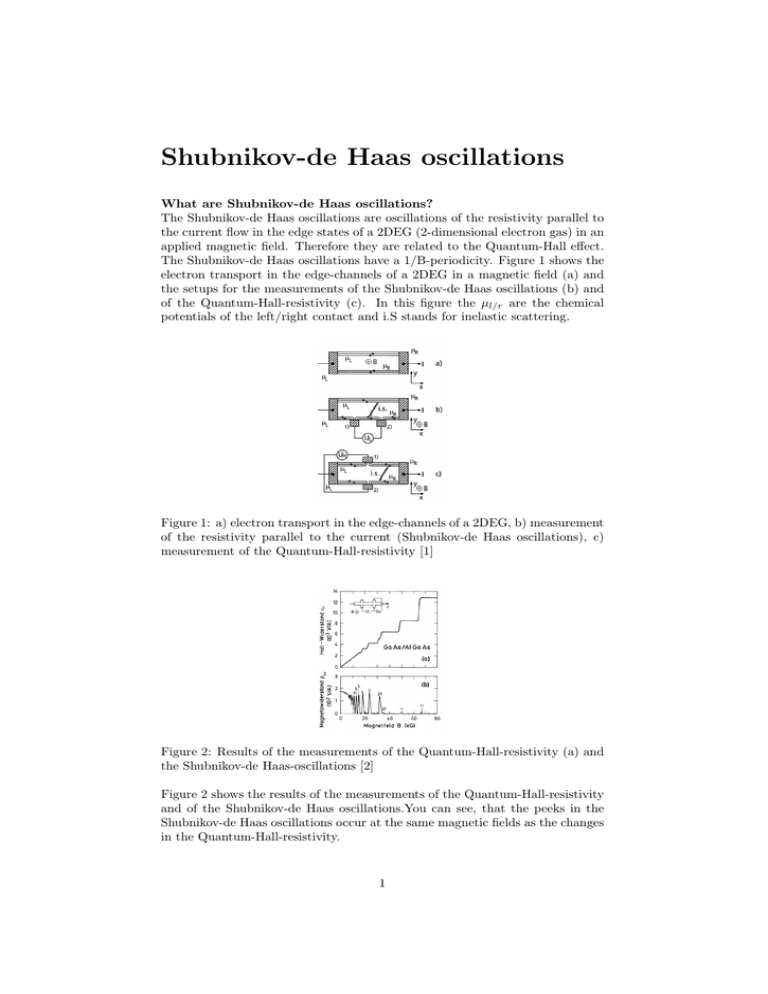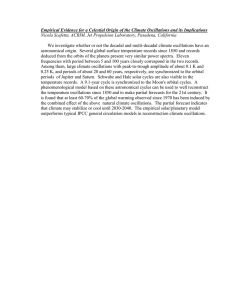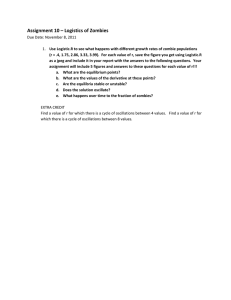Shubnikov-de Haas oscillations
advertisement

Shubnikov-de Haas oscillations What are Shubnikov-de Haas oscillations? The Shubnikov-de Haas oscillations are oscillations of the resistivity parallel to the current flow in the edge states of a 2DEG (2-dimensional electron gas) in an applied magnetic field. Therefore they are related to the Quantum-Hall effect. The Shubnikov-de Haas oscillations have a 1/B-periodicity. Figure 1 shows the electron transport in the edge-channels of a 2DEG in a magnetic field (a) and the setups for the measurements of the Shubnikov-de Haas oscillations (b) and of the Quantum-Hall-resistivity (c). In this figure the µl/r are the chemical potentials of the left/right contact and i.S stands for inelastic scattering. Figure 1: a) electron transport in the edge-channels of a 2DEG, b) measurement of the resistivity parallel to the current (Shubnikov-de Haas oscillations), c) measurement of the Quantum-Hall-resistivity [1] Figure 2: Results of the measurements of the Quantum-Hall-resistivity (a) and the Shubnikov-de Haas-oscillations [2] Figure 2 shows the results of the measurements of the Quantum-Hall-resistivity and of the Shubnikov-de Haas oscillations.You can see, that the peeks in the Shubnikov-de Haas oscillations occur at the same magnetic fields as the changes in the Quantum-Hall-resistivity. 1 Why do they occur? If you apply a magnetic field to a 2DEG, the electrons in the bulk regions perform circular motions. In the border regions of the sample, the electrons can’t perform full circular motions, because they get scattered back from the interface. These scattering events give these electrons a higher energy. The magnetic field forces scattered electrons to move in forward direction so that the current flows without resistivity in the edge channels. The energy-eigenvalues of the circular motion are the same as for the harmonic oscillator with the eigenfrequency ωc , where ωc is the cyclotron frequency: ωc = − e∗B m∗|| (1) m∗|| is the effective mass of the electrons parallel to the circular motion. Therefore the magnetic field causes a further quantisation of the energy bands. The resulting energy bands are called Landau-levels. If you solve the Schrödinger equation for free electrons in a magnetic field, you get the energy-eigenvalues of the Landau-levels: Ekz ,ν = ~2 ∗ kz2 + ~ ∗ ωc ∗ (ν + 1/2) 2 ∗ m∗ (2) In this equation ν indicates the number of the Landau-level. The energy gap between two Landau-levels is ~ ∗ ωc . Therefore the gap between the Landau-levels gets bigger when the magnetic field is increased. Figure 3 shows the Landaulevels (a). If the highest Landau-level is far away from the Fermi-energy, then there are no states available for scattering (see figure 3b) and the Quantum-Hall resistivity remains constant and the Shubnikov-de Haas-resistivity goes to zero. In that case the electron transport in the edge states is ballistic. When you increase the magnetic field, the highest Landau-level gets near the Fermi-energy (see figure 3c). In that case there are states available for scattering in the bulk regime. This scattering causes the peeks in the Shubnikov-de Haas oscillations and also the growth of the Quantum-Hall resistivity. Figure 3: a) the resulting Landau-levels after applying a magnetic field, b) highest Landau-level far away from Fermi-energy - no scattering, c) highest Landau-level near the Fermi-energy - scattering possible [3] 2 What other quantities exhibit oscillations as the magnetic field is varied? • Fermi-energy: When a Landau-level crosses the Fermi-energy as a result of a increasing magnetic field it gets deoccupied. That means, that the electrons jump into the lower lying Landau-levels. As soon as the highest Landau-level is completely deoccupied the Fermi-energy is in the next highest Landau-Level. This level has a lower energy than the now unoccupied level and therefore the Fermi-energy is lower than before. • Internal energy • Magnetization (de Haas-van Alphen oscillations) • All other quantities that depend on the density of states, e.g. Entropy, Helmoltz free energy, Pressure, Bulk modulus. The number of states is constant but when a Landau level crosses the Fermi energy and gets deoccupied, the density of states changes. This causes oscillations in all quantities that depend on the density of states. All these quantities have a 1/B-periodicity like the Shubnikov-de Haas oscillations. In the high field limit, when there is only one occupied Landau-level, this quantities all grow linearly. 3 1. H. Ibach, H. Lüth, Einführung in die Festkörperphysik, page 481 2. H. Ibach, H. Lüth, Einführung in die Festkörperphysik, page 479 3. H. Ibach, H. Lüth, Einführung in die Festkörperphysik, page 480 4




